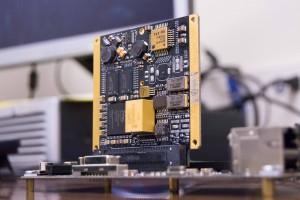BYU’s electrical engineers are researching new technology to clean circuit boards damaged by space rays.
Cosmic radiation creates malfunctions within computer chips and circuits on space devices above Earth. The purpose of the research is to prevent computer errors that can destroy data or threaten the lives of those aboard.

Even small errors can lead to bigger problems for those aboard the stations, according to Professor Michael Wirthlin.
Wirthlin received both a bachelor’s degree and a Ph.D. in electrical engineering from BYU. He is now a professor in the same department and part of the configurable computing lab, which does research largely dedicated to the study of field-programmable gate arrays, or FPGAs.
FPGAs are integrated circuits that can change and customize their function after they have been created. According to research assistant and BYU student Aaron Stoddard, unlike other chips or processors that only serve one single purpose, an FPGA can be reprogrammed in just seconds — on Earth or in space — to whatever function the situation calls for.
“The circuit will not remember what its previous function was,” Stoddard said. “But it can be reprogrammed as many times as needed.”
FPGA technology itself is not new but has recently grown in popularity.
According to Alex Wilson, another research assistant in the configurable computing lab, the need for FPGAs is increasing due to society’s growing reliance on technology.
“We are becoming more and more dependent on computers to do what we can’t and go where we can’t,” Wilson said. “We need them to go into areas that would be too dangerous for humans.”
One focus of the configurable computing lab is using FPGAs in harsh radiation environments; spacecraft, airplanes and high-energy physics experiments. Students in the lab have spent time researching certain techniques to improve FPGA technology aboard space shuttles and stations, allowing the circuits to function properly in times of high radiation.
“What happens with high-energy particles is that they can upset the contents of memory cells,” Wirthlin said. “So, my research is to try to figure out ways of using these FPGAs when there are higher forms of radiation.”
While students in the configurable computing lab continue to study the affects of the radiation itself, they mainly focus on repairing the chips after the damage has already been done. Different techniques are used to improve the FPGAs’ performance and prevent serious malfunction after the radiation upsets the circuits.
“One of the things we do is called configuration scrubbing,” Wirthlin said. “You take that configuration memory, and you scrub it, which means you keep overriding the correct data in it.You’re putting the correct data into the FPGA so if something gets damaged, it gets repaired.”
The scrubbing fixes the problem, but it does not do so immediately. Which is where the second technique, known as triple modular redundancy, comes in handy. According to Wirthlin, the engineers employ triple modular redundancy along with the scrubbing to enable a sort of “grace period.” This gives the program enough time to repair the circuit before other serious malfunctions occur.
It is important to complete both processes as quickly as possible because serious circuit damage can occur in even the smallest time window. The engineers initiate the processes from Earth, saving the vital time they need and, ultimately, a lot of money.
“What (triple modular redundancy) means is you take three copies of the circuit, and they vote; one goes bad, and the other two are voting so the circuit is still operating,” Wirthlin said. “Scrubbing comes in and fixes the bad one so all three are working. The problem is if you only do scrubbing, and the circuit fails, it could be catastrophic.”
BYU will continue to develop this cutting-edge research to improve the circuits used not only in the space program but also in devices used here on Earth. Wirthlin’s team visited various locations from Los Alamos, New Mexico, to Uppsala, Sweden, to further these techniques. Although the team has not yet gone to space themselves to reprogram any FPGAs, the possibility of a trip there still remains.




